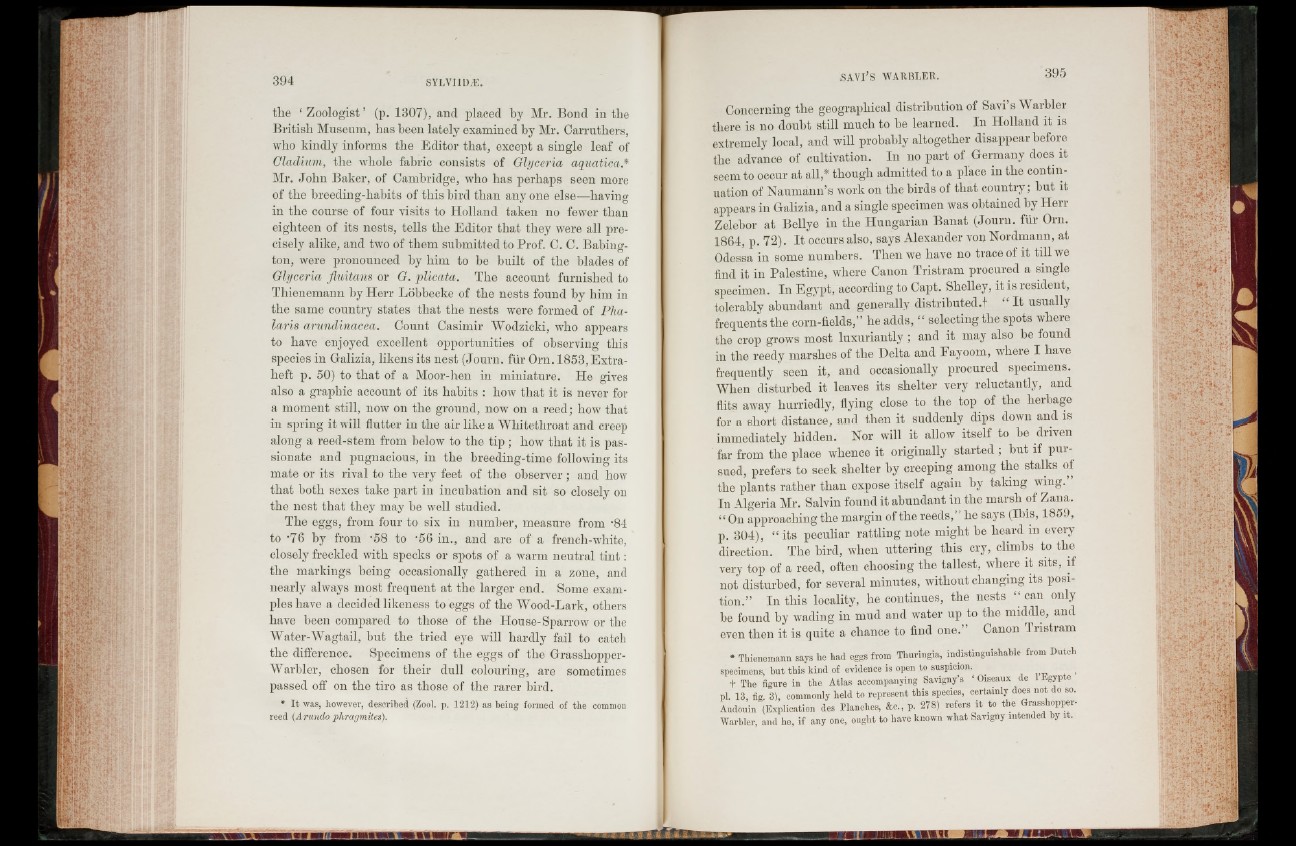
the ‘ Zoologist’ (p. 1307), and placed by Mr. Bond in the
British Museum, has been lately examined by Mr. Carruthers,
who kindly informs the Editor that, except a single leaf of
Gladium, the whole fabric consists of Glyceria aquatica.*
Mr. John Baker, of Cambridge, who has perhaps seen more
of the breeding-habits of this bird than any one else—having
in the course of four visits to Holland taken no fewer than
eighteen of its nests, tells the Editor that they were all precisely
alike, and two of them submitted to Prof. C. C. Babing-
ton, were pronounced by him to he built of the blades of
Glyceria fluitans or G. plicata. The account furnished to
Thienemann by Herr Lobbecke of the nests found by him in
the same country states that the nests were formed of Pha-
laris arundinacea. Count Casimir Wodzicki, who appears
to have enjoyed excellent opportunities of observing this
species in Galizia, likens its nest (Journ. fiir Orn. 1853, Extra-
lieft p. 50) to that of a Moor-hen in miniature. He gives
also a graphic account of its habits : how that it is never for
a moment still, now on the ground, now on a reed; how that
in spring it will flutter in the air like a Whitethroat and creep
along a reed-stem from below to the tip ; how that it is passionate
and pugnacious, in the breeding-time following its
mate or its rival to the very feet of the observer ; and how
that both sexes take part in incubation and sit so closely on
the nest that they may be well studied.
The eggs, from four to six in number, measure from -84
to -76 by from -58 to '56 in., and are of a french-white,
closely freckled with specks or spots of a warm neutral t int :
the markings being occasionally gathered in a zone, and
nearly always most frequent at the larger end. Some examples
have a decided likeness to eggs of the Wood-Lark, others
have been compared to those of the House-Sparrow or the
Water-Wagtail, hut the tried eye will hardly fail to catch
the difference. Specimens of the eggs of the Grasshopper-
Warhler, chosen for their dull colouring, are sometimes
passed off on the tiro as those of the rarer bird.
* I t was, however, described (Zool. p. 1212) as being formed of the common
reed (A rundo jpliragmites).
JTT
Concerning the geographical distribution of Savi’s Warbler
there is no doubt still much to be learned. In Holland it is
extremely local, and will probably altogether disappear befoie
the advance of cultivation. In no part of Germany does it
seem to occur at all,* though admitted to a place in the continuation
of Naumann’s work on the birds of that country; but it
appears in Galizia, and a single specimen was obtained by Herr
Zelebor at Bellye in the Hungarian Banat (Journ. fiir Orn.
1864, p. 72). I t occurs also, says Alexander von Nordmann, at
Odessa in some numbers. Then we have no trace of it till we
find it in Palestine, where Canon Tristram procured a single
specimen. In Egypt, according to Capt. Shelley, it is resident,
tolerably abundant and generally distributed.+ ‘ ‘ I t usually
frequents the corn-fields,” he adds, “ selecting the spots where
the crop grows most luxuriantly ; and it may also be found
in the reedy marshes of the Delta and Fayoom, where I have
frequently seen it, and occasionally procured specimens.
When disturbed it leaves its shelter very reluctantly, and
flits away hurriedly, flying close to the top of the herbage
for a short distance, and then it suddenly dips down and is
immediately hidden. Nor will it allow itself to be driven
far from the place whence it originally started ; but if pui-
sued, prefers to seek shelter by creeping among the stalks of
the plants rather than expose itself again by taking wing.
In Algeria Mr. Salvin found it abundant in the marsh of Zana.
“ On approaching the margin of the reeds,” he says (Ibis, 1859,
p. 304), “ its peculiar rattling note might be heard in every
direction. The bird, when uttering this cry, climbs to the
very top of a reed, often choosing the tallest, where it sits, if
not disturbed, for several minutes, without changing its position.”
In this locality, he continues, the nests “ can only
be found by wading in mud and water up to the middle, and
even then it is quite a chance to find one.” Canon Tristram
* Thienemann says he had eggs from Thuringia, indistinguishable from Dutch
specimens, but this kind of evidence is open to suspicion. ^ >
t The figure in the Atlas accompanying Savigny’s 1 Oiseaux de Egypte
pi. 13, fig 3), commonly held to represent this species, certainly does not do so.
Audouin (Explication des Planches, &c., p. 278) refers it to the Grasshopper-
Warbler, and he, if any one, ought to have known what Savigny mtende by l .